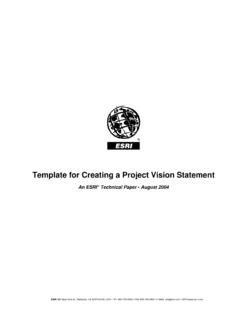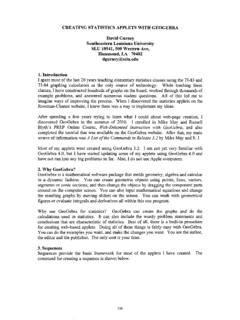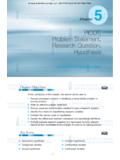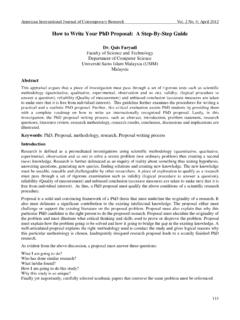Transcription of Capstone Project Problem Statements
1 Capstone Project Problem Statements Gene Dixon East Carolina University As the Capstone experience is marketed, vetted, and assessed there has been a consistent challenge in developing the Capstone student s ability to develop a quality statement of the Project Problem . This paper provides a summary report of research directed at determining what characteristics are valued in developing a Problem statement. The research found that the Problem statement and its characteristics vary with programmatic requirements and preferences. Statistics point to alignment of academia and industry on all but two pre-selected Problem statement characteristics. Industry was found to have the more rigorous point of view for the two characteristics. Corresponding Author: Introduction As the Capstone experience is marketed, vetted1, and assessed there has been a consistent challenge in developing the Capstone student s ability to develop a quality statement of the Project Problem .
2 Lectures, handouts, guidebooks and textbooks have modest efficacy in developing student skills. A review of relevant literature has provided little pedagogy or methodologies for developing the required knowledge, skills and abilities within students. Background The process of initiating and nurturing the Capstone experience within a new engineering program has offered challenges and opportunities. Paramount among these challenges has been the development of industry relations that support industry sponsored projects. After five years, the supply of projects now exceeds the available students taking the two semester course. Sponsor feedback has been overwhelmingly supportive of the Capstone curriculum. Generally, sponsor satisfaction with the Project results has exceeded faculty assessment of the Project quality. This is consistent with the tendency to focus on Project success over learning purposes2.
3 The Capstone process has begun focusing on improving Project design quality in order to meet academic goals by focusing on Project Problem Statements . Sponsored projects are requested using a template that requests potential sponsors to provide Project background, summary objectives/requirements, design expectations (deliverables) along with some administrative data including point of contact. Projects are vetted1 among a Capstone committee for selection. Students are assigned Project teams and their first assignment is to begin crafting a Problem statement for their Project . Emphasis is placed on developing the Problem statement as an iterative process consistent with Eggert3. Lectures are held once a week and the Problem statement process is discussed for one full class period and referred to frequently throughout the first semester of the two semester Capstone design sequence.
4 Internal assessments consistently indicate a weakness in the quality of student developed Problem Statements . Issues of embedded solutions, poorly developed constraints and objectives that are not quantifiable lead to weak measures, or indicators, that the design has met customer requirements. The assessment results reflect what others have found 4,5. In order to understand the rigors of developing Problem statement skills within engineering students, a survey was conducted among academicians and industry sponsors seeking to determine the key points of what is a quality Problem statement. The survey was initially developed to gain insights on how to structure both pedagogical materials and assessment rubrics to improve the Capstone experiences for senior design students. As the survey was initiated, it became apparent that a broader need for tools to develop quality Problem Statements may be needed.
5 Methods A simple questionnaire was developed and distributed to the Capstone community via affiliations with supporting agencies and organizations. Participants included Capstone instructors/coordinators (N=41), Capstone alumni (N=2; data was included with industry/sponsor data) and Capstone sponsors (N=16) as well as other industry representatives. The survey was intentionally kept brief and general. Some comments pointed out that the survey was unclear as to whether questions were dealing with sponsor Problem Statements or student derived Problem Statements . This lack of clarity was indicative of the general Problem Statements provided to students. Qualitative responses were categorized by subjectively assessing the nature of the responses. One question asked respondents to rank the value of pre-selected Problem statement characteristic components that were adapted from six recognized design textbooks (Table 1).
6 Respondents were also provided the option of adding other components they felt were of value. As expected, concerns arose about what is meant by the terms used in the survey. This was voiced by a number of respondents and is assumed to reflect a lack of standard terminology within the Capstone community as well as the lack of a single design process standard. The latter not being preferred for a number of reasons beyond the scope of this paper. It is also reflective of the issues students face when trying to understand sponsor terminology/jargon when presented with a Project proposal. While these issues make communicating challenging, the issues also lead to dialogue. In a paper of this brevity, or even a survey, dialogue is illusive. Table 1: Problem statement characteristics (coding) Respondent Mean (SD) General statement, definition or description, an overview (GnrlStmt).
7 ( ) Specific statement, definition; an exact Problem statement (SpcfStmt). ( ) Constraints/criteria (Cnstrnt). ( ) Solution path, objectives, goals (SlnPthOjb). ( ) Established (customer) need (CstmrNd). ( ) Evidence of current art research (PrArtRsch) ( ) Deliverables (Dlvrbls). ( ) Practicality (Prctclt). ( ) Success metrics (ScsMtrcs). ( ) Identified design methods (IDDsgMth). ( ) Additional questions addressed additional components or comments, indicators of precision and quality in evaluating Capstone Problem Statements , examples of quality Problem Statements and explanations of why the Problem Statements were exemplary. These questions used an open-ended format. Results General Statistical Data for the preselected Problem statement characteristics is shown in Table 2. Means test and ANOVA data analysis were consistent in identifying that significant difference only occurred between academics and industry respondents for the Problem statement characteristic identified design methods (IDDsgMth, p= ) and evidence of current art research (PrArtRsch, p= ).
8 Industry preference was stronger for both of these characteristics as part of the Problem statement than it was for the academic sample. This was somewhat unexpected for prior art as this could be conceived as an academic pursuit and yet, understanding Problem context includes understanding what has been done to address a Problem or similar problems is a valued design practice common to industry. The Problem statement characteristics question(s) included opportunities for respondents to include additional characteristics ( other ). Additional characteristics offered by respondents are shown in Table 3. From the additional characteristics, it appears a stronger need for completeness exists with academic samples than exists for the industry sample. This may be indicative of the daily exposure to, or continued experience with general or vaguely defined issues, constraints and challenges of business.
9 Table 2. General Statistics for pre-selected Problem statement characteristics. Role Academic Industry Mean SD Mean SD GnrlStmt .838 .979 SpcfcStmt .705 Cnstrnt .972 .831 SlnPthObj CstmrNd .954 .920 PrArtRsch .939 Dlvrbls .993 Prctclt .849 ScsMtrcs IDDsgMth .806 Table 3: Additional Problem statement characteristics Academic Appropriate codes (2); schedule (2); available resources; stakeholder description; terms/conditions of submission; optional scope for extra credit; budget constraints; needs statement Industry Risks to success The qualitative questions were well received and are summarized below. Responses are grouped by sample. Comments/Characteristics/Components Comments largely reflected definitions of terms and perspectives, , what is a Problem statement (or definition or scope or brief). Some comments provided insights that are worthy of note as they give further clarification and challenges to Capstone instructors and coordinators.
10 Some noteworthy examples from the academic sample: As a career design and development specialist for a large international corporation, I always try to establish a professional Problem statement. I insist on a Project planning exercise with for example a Gant chart. Regular meetings with the design teams, ensures that they recognize the need for adherence to their Project plan, and take unforeseen problems in stride. I strongly believe that lectures are not design, and few academics have the background and experience to appreciate the niceties of professional design. Capstone design would be a better experience if students had to struggle finding a compelling opportunity space and within that a valuable Problem to solve, then worry about the simpler parts of solution, design, etc. In my view the ' Problem statement' is just one part of the Problem definition that also should include a background/context statement, target specifications (preferably quanitified), design constraints, and timeline for deliverables.









